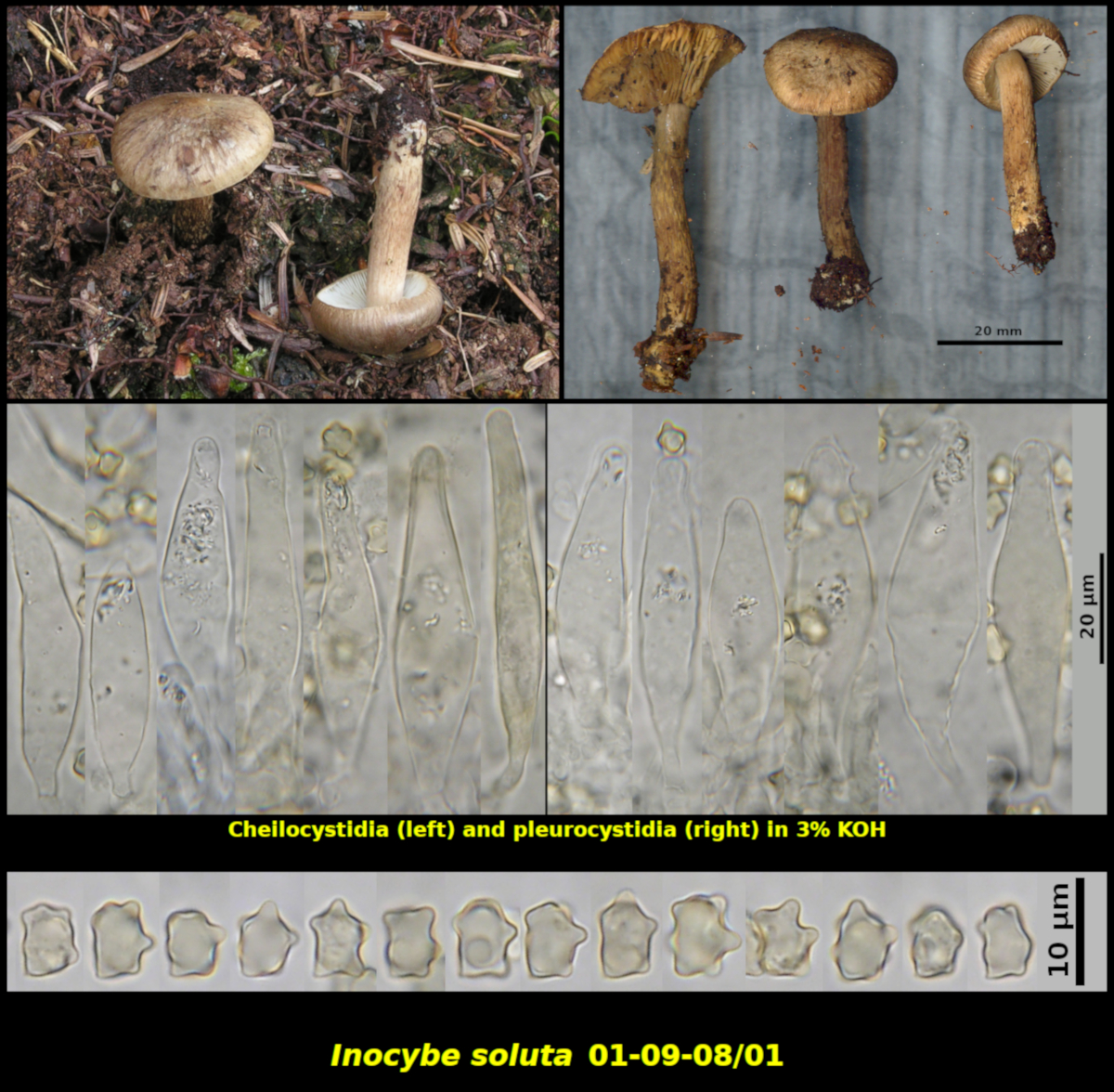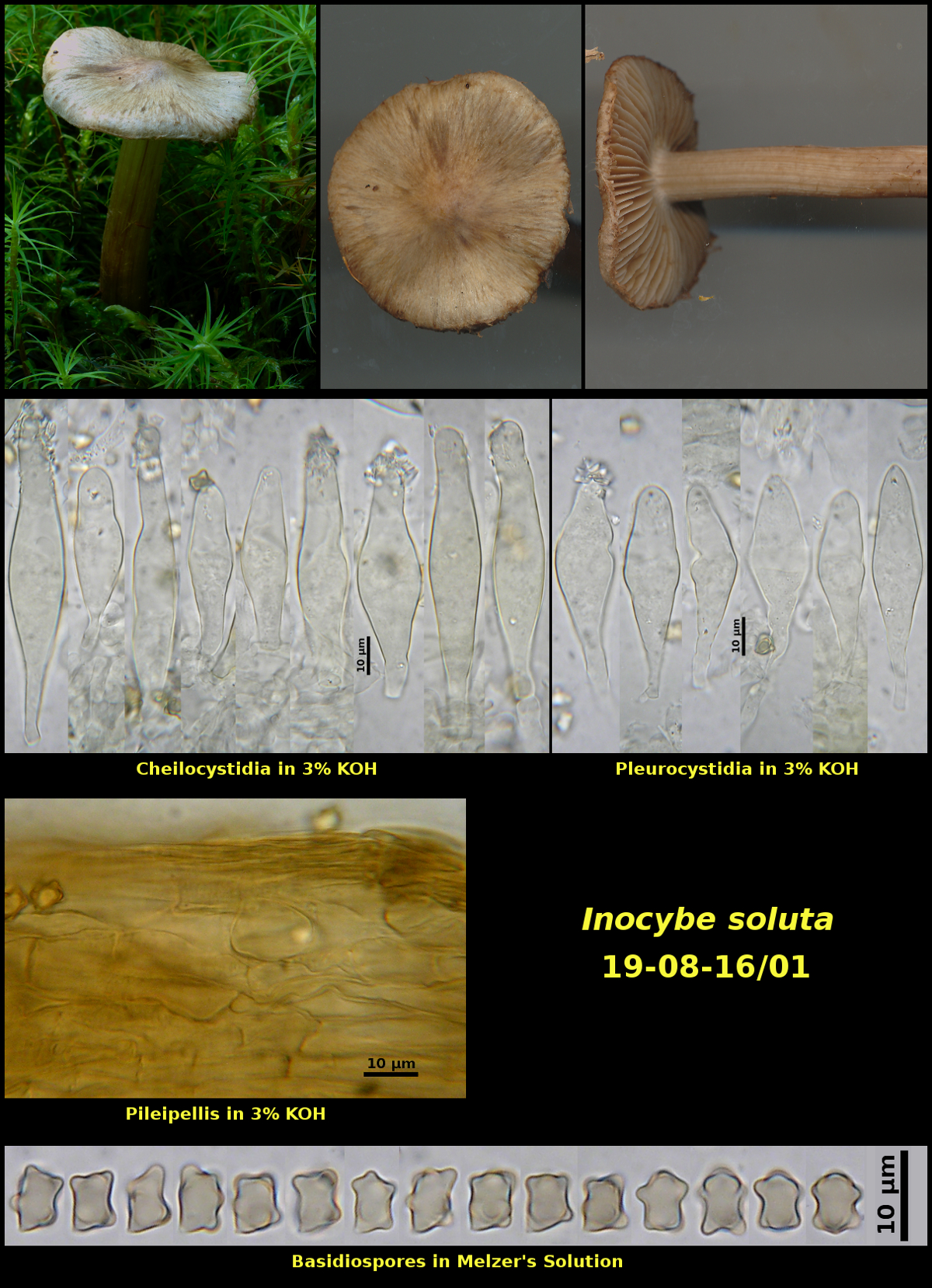Fleshy Fungi of New Brunswick >>
Inocybe soluta
Inocybe soluta Velen.


Two collections:
1. Scattered (3) in peaty soil on a small seaside embankment about 2 meters above high tide mark, growing in association with Abies balsamea and Alnus viridis, Little lepreau, New Brunswick (01-09-08/01).
Basidiospores brown in spore print, prominently nodulose, with 4-5 nodules in profile and 5-6 nodules in dorsi-ventral view, 6.0-8.4 x 4.8-6.8 µm, Q = 1.13-1.62 (average[26]: 7.2 x 5.7 µm, Q = 1.28). Cheilocystidia scattered but not forming a continuous sterile margin, ventricose to slightly lageniform, often with a constriction below the apex, thin-walled, hyaline to slightly yellow in KOH, with minute apical crystals, clamped at the base, 43-72 X 8.6-15 μm. Pleurocystidia abundant, similar to the cheilocystidia, 51-76 x 11-21 μm.
2. Solitary amongst pleurozia and polytricha along path, associated with Picea rubens and Abies balsamea, Nepisiguit Protected Natural Area, New Brunswick (19-08-16/01).
- Basidiospores forming a medium brown spore print, prominently nodulose with about 6 rounded nodules, often rather rectangular in profile, 6.3-7.7 X 4.6-6.1 μm, Q = 1.18-1.60 (average[27]: 6.9-5.2 μm, Q = 1.33). Cheilocystidia thin-walled, ventricose to sublageniform, with crystals at apex, only very slightly yellow in 3% KOH, 48-84 X 11-17 μm. Pleurocystidia similar to the cleilocystidia, 49-64 X 12-16 μm. Pileipellis a cutis of brown finely encrusted hyphae overlying a paler layer of broader cells.
We use the name I. soluta with some reservations here. It is a species described from Europe, where it grows principally in spruce forests. This habitat, plus its smooth pileus, small basidiospores and thin-walled cystidia are a good match for descriptions of European collections. The odour is somewhat problematic. Europeans usually describe the odour as spermatic, which is not the case with our several collections. Field notes accompanying most of our New Brunswick and Ontario collections describe the odour as nondescript. However, Collection 01-09-08/01 was described as having "a nondescript mushroom or slight Pelargonium odour". This suggests I. parcicoacta, described in 1977 from Nova Scotia, which was described as being pleasantly aromatic. If we consider the descriptions of "Pelargonium odour" and "pleasantly aromatic" to be possibly describing the same thing then at least Collection 01-09-08/01 might better be called I. parcicoacta. The odour in the latter, though, was obviously faint, begging the question of whether it is usually overlooked (or oversmelled) when the species is collected. Inocybe soluta and I. parcicoacta are very similar microscopically and may be distinguishable only by their very subtile odours.
Inocybe_soluta is similar to I. subcarpta, a species found in similar habitats under fir and spruce. Both have sturdy brown basidiomata with fibrillose, but not scaly, stipes and both have basidiospores that are often quadrangular in profile, and thin-walled cheilo- and pleurocystidia. They are distinguished most easily by the nearly smooth caps of I. soluta in contrast to the coarsly scaly caps of I. subcarpta.
Photo: D. Malloch (19-08-16]01).